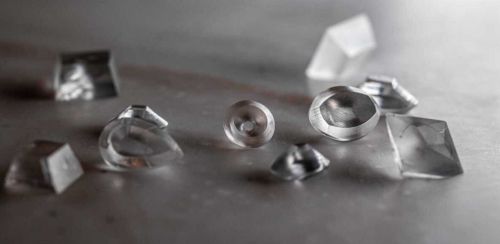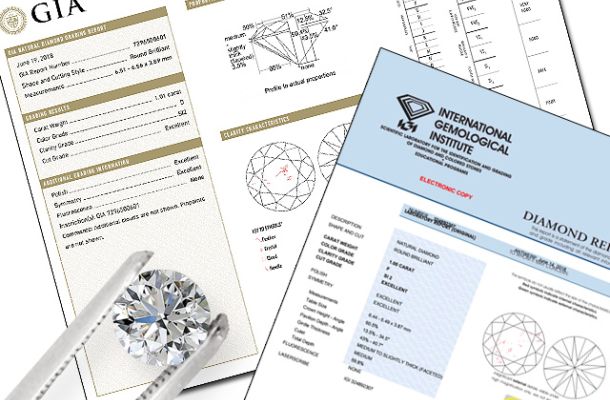
The hypothesis of the possibility of obtaining diamonds in the laboratory was first discussed in 1797, when it was found out that the stone consists entirely of carbon. It was not until 1926 that the idea became a reality, and even then, it was not a complete success. The resulting sample was far from the original, but it was the starting point of research.
It was not until 1941, after a long hiatus, that General Electrics became interested in the technology.
HPHT method of growing diamonds
The company was guided by nature’s own “technology” in the production of diamonds. The company’s specialists argued that diamonds created in the Earth are formed at a temperature of about 1300° C and a pressure of about 50,000 atm in the depths of the planet’s mantle, hundreds of kilometers below the surface. The crystals are brought to the surface by various igneous rocks.
To simulate the conditions described in the laboratory, General Electrics specialists used a press to heat carbon to 3,000 degrees, crimping a cell at 5 hPa into which were placed graphite and an iron-nickel-cobalt melt that acted as a catalyst and solvent. But production had to stop because of World War II.
World War II threatened the marketing channels for the naturally occurring diamonds originally intended for industrial cutting tools. From this point on, it became apparent that diamonds needed to be grown in the laboratory the sooner, the better; as quickly as possible.
Scientists had already discovered that diamonds are made of carbon, so their task was to determine under what conditions graphite would transform into a diamond crystal.
The research was resumed 10 years later. It was not until December, 1954 that a quality diamond suitable for mass production was obtained. They used the process now called high pressure, high temperature (HPHT).
They turned to the study of natural phenomena for a clue. The diamonds were found in an extinct volcanic rock that had been brought to the surface by lava. The stones were formed at a depth of about 200 km in the bowels of the Earth, where the pressure and temperature are very high.
To create diamonds, scientists had to find a way to keep the pressure as high as possible while maintaining a very high temperature. Graphite is incredibly stable and resistant to change. Even at very high temperatures and pressures, the carbon atoms didn’t disintegrate and turn into diamond.

Researchers found a clue by studying meteorite craters. They found the tiniest diamond crystal surrounded by metal, which they believed was formed by interaction with the meteorite. The scientists attempted to dissolve the graphite in the molten metal so that the carbon atoms from the graphite would be free to crystallize like the diamond. They placed a capsule containing the metal and graphite in a press, set the pressure at 55,000 atmospheres and the temperature between 1,400° and 1,500°, and left it for a few minutes.
The result was the first laboratory diamond. However, it was far from gem quality and was only 1 mm in diameter. But the size of the diamond was so small that it was impossible to use it in the jewelry industry.
This discovery sparked the development and study of lab-grown diamonds around the world to reach the level of gem-quality stones.
They managed to solve the size problem in 1970, but even then the stones were never larger than 1 carat.
In 1985, researchers were already able to grow large, multicolored diamonds using HPHT techniques, but their commercial production was not profitable: the equipment was very expensive to install, operate, and maintain, and the diamonds often had metallic inclusions that were visible to the eye.
The CVD Method
Since the 1950s the chemical vapor deposition (CVD) method of producing diamonds became more and more popular. The process involves breaking down gas molecules and using the carbon atoms within these molecules to build up diamond structures. The CVD method is highly controlled, allowing for the production of diamonds that are often superior in quality to those found naturally.

The first CVD diamonds were produced in the 1950s, but the process was not very efficient, and the diamonds were not of high quality. In the 1970s, there was renewed interest in the process, and the process was improved.
In the 1990s, CVD diamonds began to be commercially produced. The diamonds were still relatively expensive, but they were becoming more affordable. In recent years, the cost of CVD diamonds has continued to decline, and they are now a viable alternative to mined diamonds.

The present state of CVD diamond production is very promising. The process is now well-established, and the quality of the diamonds is very high. The cost of CVD diamonds is continuing to decline, and they are becoming increasingly popular.
Today, HPHT and CVD lab-grown diamonds are widely used in industry along with natural diamonds, made possible by their identical physical properties. Also, laboratories can grow really large stones.
The gem-quality diamonds produced by modern laboratory synthesis techniques can be flawless in clarity and color. Many global brands are launching entire jewelry collections with grown diamonds.
Like their natural counterparts, lab-grown diamonds are not only beautiful, but also incredibly strong and durable.

Today, lab grown diamonds are created using both the HPHT and CVD processes, and they have become a popular choice for engagement rings, earrings, and other jewelry. These diamonds are physically and chemically identical to natural diamonds, and they are graded using the same criteria as natural diamonds.
The creation of lab grown diamonds has had a significant impact on the diamond industry, offering consumers a more affordable and ethical option without sacrificing quality or beauty. And with ongoing advancements in technology, the future of lab grown diamonds looks bright.




